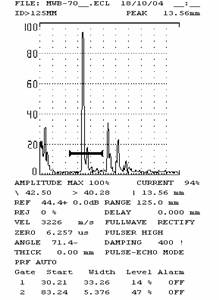|
    
Manual
Ultrasonic (UT) Weld Inspection
(Download
Brochure, 100Kb)
 Welding
is the most widespread way of connecting metallic mechanic parts of
industrial equipment. The integrity of these connections during
manufacturing as well as during the operation of mechanical equipment is
of critical importance for the safety of the installation. Welding
is the most widespread way of connecting metallic mechanic parts of
industrial equipment. The integrity of these connections during
manufacturing as well as during the operation of mechanical equipment is
of critical importance for the safety of the installation.
The use of
ultrasounds for the integrity inspection of welds is a common practice in
the Industry. The applied technique consists of scanning the weld mass and
the Heat Affected Zone (HAZ) with ultrasonic beams emitted by angle probe
that is moved manually along the lateral region of the weld.
 The
detection and sizing of discontinuities is performed by receiving and
evaluating the beam reflected from the discontinuity surface. The
detection and sizing of discontinuities is performed by receiving and
evaluating the beam reflected from the discontinuity surface.
Modern digital
instruments with capability of storing the discontinuity signals are used
for the inspection. Common UT transverse-wave angle probes are used, while
special double-crystal longitudinal-wave probes are used for the
inspection of thick-grained steels (stainless steels).
 Advantages
of the method: Advantages
of the method:
-
Quick and direct
results.
-
No protection
against radiation required, neither interruption of other peoples work.
-
In-service
inspection.
-
Inspection of
complex geometry welds with profile analysis of the weld using a PC.
-
Inspections
performed according to international standards ASME, EN etc.
-
Final technical
report that contains position, depth and type information of
discontinuity.
-
Storage of the
discontinuities signals and inspection parameters.
-
Sensitivity in
critical discontinuities detection (e.g. cracking).

Envirocoustics
also provides weld inspection
services using the TOFD (Time Of Flight Diffraction) technique and
weld inspection services using Eddy Currents.
|